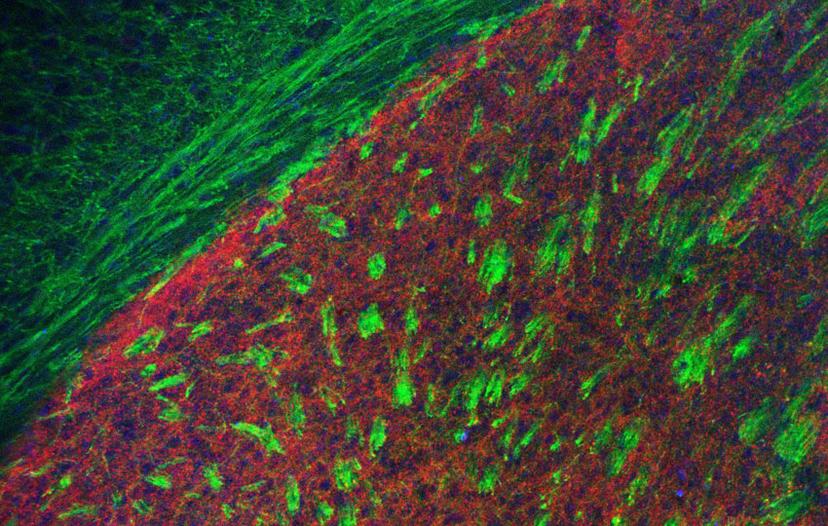Using Transgenic Mouse Models to Improve Understanding of Epilepsy and Advance the Search for Effective Therapeutics
Learn how molecular biologist Dr. Antonella Pirone is investigating synaptic organization and helping to find and develop drug candidates to treat epileptic disorders
30 Apr 2017

Immunofluorescence labelling of Myelin basic protein and Tyrosine hydroxylase on mouse brain slice. Source: Dr. Antonella Pirone

Antonella Pirone, Ph.D. Dr. Pirone has a background in molecular medicine and genetics, but her interest in ion channels and their role in synaptic and network dysfunction led her to move towards neuroscience in her postdoctoral training. She is now a Research Associate in the Michele Jacob Laboratory at Tufts University, USA, researching synaptic function in neurodevelopmental disorders.
Dr. Antonella Pirone is a Research Associate in Professor Michele Jacob’s laboratory at Tufts University, Massachusetts, USA. Dr. Pirone’s current research is utilizing a transgenic mouse model to investigate the causes behind developmental diseases such as autism and epilepsy, and aid the search for new therapeutics.
The research focus of the Michele Jacob laboratory is the role of APC (adenomatous polyposis coli protein) in the synapse. APC is the major negative regulator of the β-catenin/Wnt signaling pathway, which regulates cell division and growth. In the brain, this signaling pathway is critical for normal formation and function of brain circuits. Large-scale genetic screens have identified the APC gene as a risk factor for neurodevelopmental disorders, such as autism spectrum disorders and intellectual disabilitiesand epileptic encephalopathies[1].
APC – the synaptic organizer
“Professor Michele Jacob’s studies have identified APC protein as a key synapse organizer in the excitatory neurons and more recently have described mechanisms responsible for synaptic dysfunction in autism, cognitive disabilities and seizures,” said Dr. Pirone. To investigate this, Professor Jacob’s laboratory developed a transgenic mouse model in which the Apc gene is knocked out in the excitatory neurons. The knock-out mice (APC cKO) display a very complex phenotype, which includes autistic-like behaviors, cognitive impairment and spontaneous seizures[1].
“I’m using this transgenic mouse model to investigate the cause behind one of the phenotypes, infantile spasms” explained Dr. Pirone. Infantile spasms constitute a catastrophic childhood epilepsy syndrome, characterized by neonatal motor spasms, lifelong seizures and cognitive deficits. The APC cKO mice closely mimic disease features and progression in humans[2].
“As there are few animal models of infantile spasms and very few drugs which work, this transgenic mouse model has received a lot attention from researchers in the field of epilepsy,” Dr. Pirone said.
I’m using this transgenic mouse model to investigate the cause behind one of the phenotypes, infantile spasms.
Assessing changes in the excitatory neurons
Dr. Pirone began her research into the cause of infantile spasms by combining molecular and functional techniques to determine how knocking out APC affects brain development and function.
“Receptor and transporter antibodies have been helpful for my research as we are trying to understand whether the presynaptic receptors and transporters in the APC cKO mice neurons have a different expression and spatial distribution compared to those in the wild type mice,” Dr. Pirone explained.
Dr. Pirone immunostained mouse brain sections using BioLegend’s primary antibodies against receptors and transporters of interest, such as glutamate transporters (VGlut1 and VGlut2), AMPA-selective glutamate receptors (GLUR1 and GLUR2) and NMDA receptors (NMDAR2A and NMDR2B). Dr. Pirone then used secondary antibodies conjugated to fluorescent dyes to visualize the abundance and distribution of these proteins in the cell membrane using confocal microscopy. Using this technique, she was able to observe defects in synaptic organization in the APC cKO mice. “I know BioLegend for their neurological receptor and transporter antibodies,” Dr. Pirone said.
Dr. Pirone combines morphological data and electrophysiology in her studies. Increased excitatory post-synaptic currents, which indicate aberrant synaptic activity, were seen to correlate with specific brain regions with an aberrant expression of presynaptic proteins. This confirms the role of APC in normal brain development and function[2].
Searching for new therapeutics
We want to find a target which is only expressed in brain regions to reduce the systemic effects of the drug.
Increased understanding of the role of APC in organizing the synapse and its association with intellectual disorders, autism spectrum disorders and epilepsy, has highlighted a new molecular pathway as a potential target for early therapeutic intervention.
Dr. Pirone is now using the APC cKO mouse model to discover molecular targets and new therapeutic compounds. “We’re now testing new drug candidates for infantile spasms in our mouse model,” Dr. Pirone said. To assess the effect of the drug candidates, Dr. Pirone is assessing the difference in synaptic organization and function between treated and non-treated mice. To do this, she is continuing to use confocal microscopy and electrophysiology techniques developed in her earlier research.
As well as being effective, potential drug candidates must also be safe and have few side effects. “We want to find a target which is only expressed in brain regions to reduce the systemic effects of the drug and therefore minimize side effects,” explained Dr. Pirone.
Not only has the creation of the APC cKO mouse model allowed the Michele Jacob Laboratory to investigate the role of APC in neurodevelopment, it has also provided a new animal model which can be used to enhance target and drug discovery for neurodevelopmental disorders.
References:
1. Mohn, JL and Alexander, J. (2014). Adenomatous polyposis coli protein deletion leads to cognitive and autism-like disabilities. Molecular Psychiatry, 10 (19), 1133-1142.
2. Pirone, A et al. (2017). APC conditional knock-out mouse is a model of infantile spasms with elevated neuronal β-catenin levels, neonatal spasms, and chronic seizures. Neurobiology of Disease, 98, 149-157.
Find out more about BioLegend antibodies, or visit BioLegend’s neuroscience page to learn more about neuro-related products.
